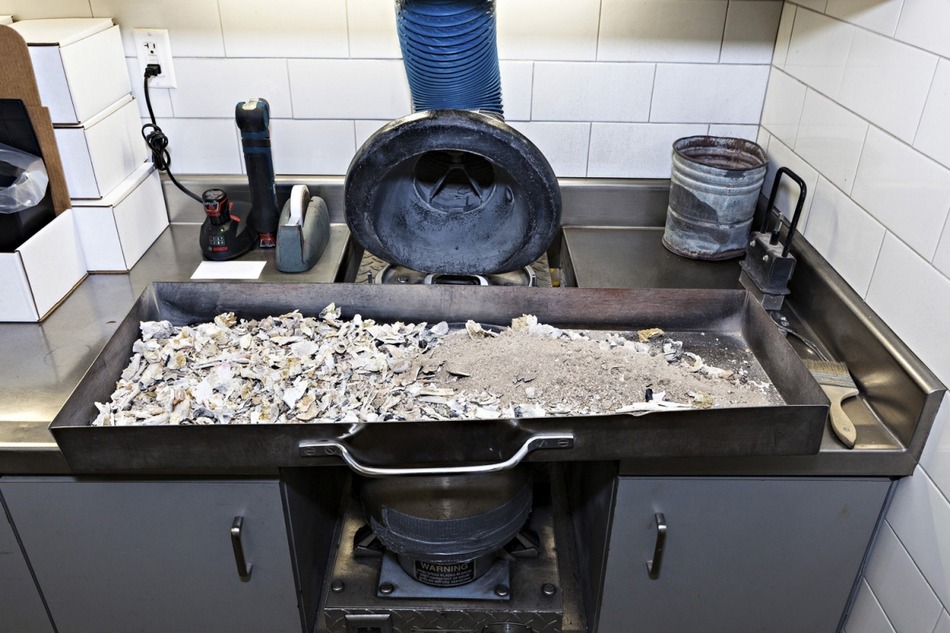"Ash" is a powdery residue left after a combustible substance is subjected to intense heat. There is coal ash, wood ash, flue ash, and many others. Cremated remains are mostly what is known as "Bone ash" (primarily calcium and phosphorus) and, as I will explain below, will not simply disappear if dumped into water.
In modern cremations, bones are pulverized and run through a system which removes trace metals, resulting in a few pounds of remains. I could not find any literature specifically addressing the solubility of bone ash in water, but the topic is mentioned in a few experiments.
From a study "Simple Method for Preparing Bone-Free Ash from Fishery Products Analyzed for Mineral Content" (my emphasis):
During the course of our routine mineral analyses of several thousand samples of fresh and canned fishery products, we observed that Ca and strontium (Sr) particularly had higher standard deviation among replicates than other elements such as potassium (K) and magnesium (Mg). Occasionally it was observed what appeared to be small bits of bone in the ash, particularly in the ash of canned samples. By trial and error, it was found that by adding water to the ash, the ash went into solution but not the “ashed bones”. Preliminary experiments wherein a few pieces of bone were added to the samples prior to ashing showed that the added pieces remained essentially intact and that a simple water wash dissolved all but the bone ash.
...
Conclusion
A simple method was developed for separating bits of bone from the ash of canned and fresh fish samples prior to determining the mineral content in the samples. The method is very simple, employing only water for separating the bone from the ashed samples.
Another study titled "The Calcium Salts of Bone" found that a very small percent of bone is soluble in water. From the study:
The figures given below show the untreated composite sample of bone cortex, which was the basis for all the bone preparations analyzed, to have consisted of roughly 65 per cent inorganic material and 10 per cent moisture. The remaining 25 per cent is chiefly the organic matrix of the bone, although it may include some inorganic constituents which would be lost in ashing. The very small amounts of alcohol-ether-soluble material indicate the bone cortex to be almost free from fats and lipoids; water-soluble bone matrix, as well as the inorganic salts of bone, are only very slightly soluble in water.
Pure tricalcium phosphate powder is also known as "synthetic bone ash". It is described as "Practically insoluble in water" on pubchem: https://pubchem.ncbi.nlm.nih.gov/compou ... creen=true
In a 2004 study published in J Forensic Sci titled "Cremation Weights in East Tennessee" it was found that cremated remains weigh on average 2350g (5.18 lbs) per female and 3380g (7.45 lbs) per male, with median age 77 and 65 respectively. The minimum recorded weight of cremated remains was 1050g (2.3 lbs) for a woman and 1865g (4.11 lbs) for a male.
According to this calculator: https://www.mainelyurns.com/urn-size-chart.html
For every pound a person is, that is 1 cubic inch of ashes. Therefore, a 130 lb (59kg) person would be cremated into 130 cubic inches (2,130 cubic cm) of ashes.
The following video shows an experiment (starting at: 3:26) on the solubility of calcium in water:
The video shows, quite plainly, that it is not soluble in water.
Simply put, a cremated body is not soluble in water. Therefore, if you dumped the cremated remains of a person into a pond, only a very small percentage of these remains would dissolve, and the vast majority (which is non-soluble) would pool at the bottom.
It has been asserted that over 1 million people were murdered by Nazis at Auschwitz in homicidal gas chambers, then cremated. If the average weight was 130 lbs (59kg) this would result in 75,231 cubic feet (2,130 cubic meters) for the burnt remains of 1 million people (assuming 1 cubic inch per pound of body weight). In order to make excuses for the utter lack of massive piles of human remains (cremated or otherwise) it has been alleged by some that these cremated remains were deposited en masse into a few "ash ponds" at Auschwitz.
I estimate that the remains of 400-500 people could fit within 1 cubic meter. According to the article in this thread posted by Hannover: viewtopic.php?f=2&t=12262
between 750-3,000 people could fit into the gas chamber at once. Multiple sources claim 6,000 people were killed in these gas chambers per day at Auschwitz, which would result in over a dozen cubic meters of cremated remains per day needing to be dumped in alleged "ash ponds"
Assuming every single body was cremated, this would result in millions of pounds of remains that are almost entirely insoluble in water. If this was indeed true, the majority of these burnt remains would still be able to be excavated. They would likely have settled towards the bottom of the pond in a manner primarily dictated by particle size. The entire basin of these alleged "ash ponds" would, quite evidently, be covered in bone ash & possibly small fragments of bones.
Judging by the photos provided in this link: https://furtherglory.wordpress.com/2011 ... -birkenau/
that simply is not the case.









